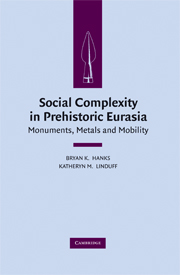Book contents
- Frontmatter
- Contents
- Contributors
- Foreword: From Myth to Method: Advances in the Archaeology of the Eurasian Steppe
- CHAPTER 1 Introduction: Reconsidering Steppe Social Complexity within World Prehistory
- PART ONE FRAMING COMPLEXITY
- PART TWO MINING, METALLURGY, AND TRADE
- PART THREE FRONTIERS AND BORDER DYNAMICS
- CHAPTER 13 Introduction
- CHAPTER 14 Violence on the Frontiers? Sources of Power and Socio-Political Change at the Easternmost Parts of the Eurasian Steppe during the Late Second and Early First Millennia BCE
- CHAPTER 15 First-Millennium BCE Beifang Artifacts as Historical Documents
- CHAPTER 16 Blurring the Boundaries: Foragers and Pastoralists in the Volga-Urals Region
- PART FOUR SOCIAL POWER, MONUMENTALITY, AND MOBILITY
- Index
CHAPTER 14 - Violence on the Frontiers? Sources of Power and Socio-Political Change at the Easternmost Parts of the Eurasian Steppe during the Late Second and Early First Millennia BCE
from PART THREE - FRONTIERS AND BORDER DYNAMICS
Published online by Cambridge University Press: 26 January 2010
- Frontmatter
- Contents
- Contributors
- Foreword: From Myth to Method: Advances in the Archaeology of the Eurasian Steppe
- CHAPTER 1 Introduction: Reconsidering Steppe Social Complexity within World Prehistory
- PART ONE FRAMING COMPLEXITY
- PART TWO MINING, METALLURGY, AND TRADE
- PART THREE FRONTIERS AND BORDER DYNAMICS
- CHAPTER 13 Introduction
- CHAPTER 14 Violence on the Frontiers? Sources of Power and Socio-Political Change at the Easternmost Parts of the Eurasian Steppe during the Late Second and Early First Millennia BCE
- CHAPTER 15 First-Millennium BCE Beifang Artifacts as Historical Documents
- CHAPTER 16 Blurring the Boundaries: Foragers and Pastoralists in the Volga-Urals Region
- PART FOUR SOCIAL POWER, MONUMENTALITY, AND MOBILITY
- Index
Summary
This chapter focuses on the late second and early first millennia bce, a period in which, according to many scholars, societies throughout the Eurasian steppe underwent meaningful changes (e.g., Hanks 2002: 183; Khazanov 1984: 92–93; Renfrew 2002: 4–7), and addresses models for social, political, and cultural change in frontier zones. Theories addressing socio-political change can be classified into two types: indigenous and exogenous. Indigenous theories see change as evolving through processes such as competition or cooperation among local individuals and groups and their interaction with the local environment. Exogenous theories attribute change, including the development of socio-political complexity, to forces outside the local communities. Such forces can be human-derived – large scale migrations, for example – but also natural, such as climatic changes. Although external and internal processes are not mutually exclusive, the intellectual traditions in which models evolved to explain socio-political change in prehistoric societies commonly make them seem that way.
Introduction
Nowhere is the blend of external and internal dimensions of change more evident than in the Eurasian steppe, where contacts among societies were frequent but where unique local cultures, adaptations, and hierarchies evolved since at least the third millennium bce. This is especially true at the frontier zones of this large region: areas in which intensive interactions took place between societies with different economic strategies, ideologies, and cultural attributes.
- Type
- Chapter
- Information
- Social Complexity in Prehistoric EurasiaMonuments, Metals and Mobility, pp. 241 - 271Publisher: Cambridge University PressPrint publication year: 2009
- 8
- Cited by

